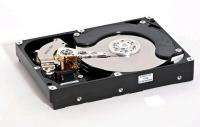October 23, 2009 feature
What Comes After Hard Drives?

(PhysOrg.com) -- The ability to store and retrieve data is an important component of today's computers, as well as other modern electronic devices such as cell phones, video game consoles, and camcorders. Since their invention in the 1950s, magnetic-based hard disk drives (HDDs) have been the primary method of nonvolatile storage. However, researchers are currently developing several new and promising nonvolatile memory (NVM) technologies, but for one of them to replace HDDs within the next decade, it will be a challenge.
According to a new study, if HDDs continue to progress at their current pace, then in 2020 a two-disk, 2.5-inch disk drive will be capable of storing more than 14 TB and will cost about $40 (today, a typical 500 GB hard drive costs about $100). Although flash memories have also become popular - with advantages such as lower power consumption, faster read access time, and better mechanical reliability than HDDs - the cost per GB for flash memories is nearly 10 times that of HDDs. In addition, flash memory technology will reach technical limits that will prevent its continued scaling before 2020, keeping them from replacing HDDs.
In a study published in a recent issue of IEEE Transactions on Magnetics, Professor Mark Kryder and PhD student Chang Soo Kim of Carnegie Mellon University have investigated 13 up-and-coming NVM technologies to see whether one of them might outperform HDDs on a cost-per-TB basis in 2020. Their results showed that most technologies will probably not be competitive with HDDs or flash memories at that time, except for two potential candidates: phase change random access memory (PCRAM) and spin transfer torque random access memory (STTRAM).
As Kryder and Kim explained, PCRAM is based on the phase change properties of chalcogenide glass. With the application of heat, the glass can switch between two different states (amorphous and crystalline) to be used as a memory. With their small cell size and ability to store multiple bits per cell, PCRAMs have the potential to offer high densities and be cost-competitive with HDDs, but their biggest drawback is that they require somewhat higher power than most other technologies. PCRAMs are already beginning to be marketed by Numonyx Inc., an Intel-ST Microelectronics joint venture, and so are closer to practical realization than STTRAM.
STTRAM, which is similar to magnetic RAM, uses a spin polarized current to write data by reorienting the states of a magnetic tunnel junction between parallel and anti-parallel orientations. In their evaluation, Kryder and Kim found that STTRAMs appear to potentially offer superior power efficiency, among other advantages. If STTRAMs could be improved to store multiple bits per cell, the researchers predict that STTRAMs’ density could make them candidates for replacing flash memory and possibly HDDs.
“We were surprised to find that the study indicated that, even in 2020, hard drives were likely to be considerably less expensive on a cost per terabyte basis than any of the competing technologies,” Kryder told PhysOrg.com. “It was also somewhat surprising to find that the technical potential of a technology was not necessarily well-correlated with where the industry was investing the most dollars; rather, industrial firms are tending to invest where they have the most know-how. This is not necessarily the wisest decision, but is quite understandable.”
The other NVM technologies that Kryder and Kim evaluated were ferroelectric RAM, magnetic RAM, carbon nanotube RAM, probe memory, holographic memory, copper bridge RAM, resistive RAM, racetrack memory, single electron memory, molecular memory, and polymer memory. Although these technologies offer potential, each of them still faces significant performance challenges over the next decade. Holographic memory, for example, offers high density and is inexpensive, but it currently only offers “write once, read many times” (WORM) functionality, and with its 50-year storage lifetime it may be better suited to the archival market. The researchers also pointed out the intriguing concept behind single electron memory, where information could be stored in something as small as a single electron, but they predicted that this technology likely won’t be practical until beyond 2020.
Kryder, who has previously been CTO for Seagate Technology, the world's largest hard drive maker, explained that he had been continually asked to review new technologies that were often touted as potentially replacing hard drives.
“Feedback from industrial associates has indicated that having a structured set of criteria to evaluate technologies was very useful and that the study has helped them to prioritize the technologies that they look at,” he said. “This study allowed us to identify the most promising technologies on which to work, and we are now attempting develop multi-level cell STTRAM.”
More information: Mark H. Kryder and Chang Soo Kim. “After Hard Drives - What Comes Next?” IEEE Transactions on Magnetics, Vol. 45, No. 10, October 2009.
Copyright 2009 PhysOrg.com.
All rights reserved. This material may not be published, broadcast, rewritten or redistributed in whole or part without the express written permission of PhysOrg.com.
















